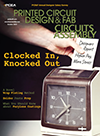The SI-V200 model automatic optical inspection machine is said to be suitable for detection of inaccurate component mounting, reversed component, missing component, incorrect polarity, missing solder, bridging and solder quantity. Has a two-megapixel color CCD camera and a three-stage white ring lighting system in a cast-iron frame. When used in standard resolution (15.5μm), the field of view capacity reportedly increases by 54% compared to previous models. Said to provide availability of high-res mode (11.0μm), permitting inspection of 01005-sized components. Works in conjunction with a tele-centric lens. Uses a linear motor to drive the X axis; uses Magnascale for position control and feedback.
Sony Manufacturing Systems America Inc., http://www.sonysms.com
Sony Manufacturing Systems America Inc., http://www.sonysms.com
New options to the FeederMaster system include upgraded software and an enclosed camera. The software is said to allow the user full control, including programmable zoom facility. Permits each lane to be calibrated at a selectable speed so that the initial calibration can be carried out at a speed that suits the operator and the complete feeder can still be tested at full speed later. Is said to be important for smaller components such as 0402 and 0201 passive case sizes. An optional variable LED Light Ring is available. Has motor power monitoring during calibration.
AlternativeSMT, www.feedermaster.com or www.alternativeSMT.com
Benchmark 2.0 machine operating software enhances post-print inspection, integrates barcode scanning for product traceability and process verification, singulates processing of indexed Auer boat substrates, and supports CAMX machine data-streaming per IPC-2541. Available on MPM Accela printer. Includes SpeedVision high-speed inspection architecture that improves board area inspection quantitatively (with data), reportedly at line speeds.
Speedline Technologies, www.speedlinetech.com
Indium5.1AT no-clean Pb-free solder paste offers low voiding at via-in-pad (reported 5% range over many different profiles with BGAs), printability, wetting and a robust reflow profile window. Formulated to minimize impact of downtime on printed deposit volumes.
Indium Corp., www.indium.com
1H20 AR3 water-based conformal coating is a high solids, fast drying, water-based acrylic for high volume, inline dip coating. Electrical properties are said to be comparable to solvent-based acrylics; adhesion properties and chemical and solvent resistance are reportedly superior. Meets MIL-I-46058C, IPC-CC-830 and UL746. Also comes as spray.
Humiseal, www.humiseal.com
Aegis Traceability and Control Validation Kit validates manufacturers’ plant traceability and control. Provides physical materials and procedural guide to determine a factory’s traceability and control capability, and rates the results in a formalized matrix. These ratings demonstrate manufacturers’ capabilities, communicate these capabilities to customers or auditors, and provide a starting point for improving capabilities.
Press Releases
- StenTech Strengthens Precision Parts Platform with AME Acquisition
- Count On Tools Enhances Selective Soldering Precision with Expanded Nozzle Lineup
- ViTrox Presents Advanced Inspection and Smart Manufacturing Solutions at NEPCON Asia 2025
- ASC Sunstone Circuits Adds New Options to OneQuote While Maintaining Real-Time Pricing on Core PCB Features


